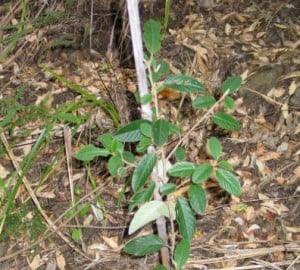[vc_row][vc_column][vc_column_text]
Rongoa is the Māori term for medicines that are produced from native plants in New Zealand. Also included in this page are all other uses of native plants by Māori.
[/vc_column_text][/vc_column][/vc_row][vc_row][vc_column][vc_column_text]
AkeakeUsed for tools and weapons This small tree has hard black wood with creamy-white stripes. The slender trunk was favoured material for weapons and tool handles. Dodonea viscosa |
 Akeake |
AruheUsed for food The roots of this common fern were dug in winter and roasted. When required for food they were pounded to release the starchy material. Young shoots were eaten fresh. Pteridium esculentum |
 Aruhe Photo, Iain MacDonald |
HangehangeUsed for flavouring food and medicine A small coastal tree with very brittle branches. To add flavour, food was wrapped in the shiny leaves prior to steaming in the hangi. Sap from green leaves was applied to skin diseases on children. Geniostoma rupestre |
 Hangehange |
HarakekeUsed for beliefs, clothing, fishing, medicine and boats The dark green leaves of flax contain one of the strongest natural fibres known. The leaves were plaited for baskets, clothes and fishing nets. The tohunga (keeper of knowledge) used the leaves for healing rites, by applying the root juice to skin problems, like boils. A bundle of dried flower stems made rafts. Phormium tenax |
 Harakeke |
HohereUsed for clothing, food and medicine The bark of this small tree was soaked in water for two days in order to release an edible jelly. This jelly was also employed in bathing sore eyes .The lacelike inner bark was dried to make a rough cloth known as aute, used for clothing. Hoheria populnea |
 Hohere |
HoropitoUsed for beliefs and medicine The small oval leaves of this shrub have a hot peppery taste. They were chewed to relive toothache. Small branches were used by the tohunga (keeper of knowledge) to lift tapu (something sacred or forbidden) Pseudowintera colorata |
 Horopito |
KaikomakoUsed for starting fires A sharp pointed stick was rubbed vigorously along a groove in a dry piece of pata or ma hoe to make fire. Pennantia corymbosa |
 Kaikamako |
Kanuka and ManukaUsed for building and weapons Small aromatic “tea trees”, which frequently form dense shrub. Weapons and tools were fashioned from heavy straight stems. The trunks as well as the brushwood were used as building materials. Kunzia ericoides, Leptospermum scoparium |
 Flowering Manuka |
KarakaUsed for food and medicine This coastal tree was so valued that it was one of the few trees cultivated for its clusters of orange fruits, which were known as kopi. The hard seeds, which in their raw state are extremely poisonous, have an edible fleshy covering. To remove the poison the fruits were steamed for several hours and immersed in running water for several weeks. The kernels were ground into flour and baked into a bread The shiny upper surface of the leaves healed wounds. Corynocarpus laevigatus |
 Karaka |
KareaoUsed for cordage and medicine The long supple stems of this tall vine formed ladders to climb cliffs, trees and enemy palisades. Also used for lobster pots and baskets. Together with rata, it was the most valuable tying material for fences, houses and canoes. Burning stems cauterised wounds. Ripogonum scandens |
 Kareao |
KauriUsed for building canoes This massive tree was second only to the totara for canoe building in the north. After an elaborate ritual, the tree was felled and the trunk hollowed out, using stone tools and fire from burning dry rewarewa wood. Agathis australis |
 Young Kauri |
KawakawaUsed for beliefs, insect repellent and medicine This large shrub with shining green leaves is one of the most important in Māori cultual lore. Leafy shoots were used in ceremonies connected with birth and death as well as for lifting tapu. A branch laid at the entrance of a marae signified disaster in the village. The leaves were chewed to relieve toothache. Burning the leaves deterred insects from food crops. Macropiper excelsum |
 Kawakawa |
KiekieUsed for cordage and medicine Flowers and fruit of this climbing plant were eaten. The leaves of this and several others incuding oioi were used for weaving and tying Freycinetia banksii |
 Kiekie flower Photo by John Braggins |
KohuhuUsed for ceremony Small leafy branches of this and other trees are waved to accompany a chant welcoming important visitors to the marae. Pittosporum tenuifolium |
 Kohuhu |
Korokio TarangaUsed for beliefs and medicine Small branches were used by the tohunga to lift tapu from food being cooked in the hangi. The hard dried wood was also used as a medical instrument for excising wounds. Corokia buddleoides |
 Korokia Taranga |
KoromikoUsed for beliefs and food Used in many rituals including by the tohunga to ensure a good crop of kumara. Tips of shoots chewed to alleviate hunger. Hebe stricta |
 Koromiko |
KotukutukuUsed for food The largest fuchsia species in the world forms a small tree with flaking bark. When ripe the sweet black berry, konini was eagerly sought for food. Fuchsia excorticata |
 Kotukutuku |
 Kumarahou |
|
MakomakoUsed for food A small tree bearing reddish, almost transparent leaves. The current sized berries were sought for food. Aristotelia serrata |
 Makomako |
MangemangeUsed for bedding Wiry stems of this climbing fern werre bundled and used as bedding. Lygodium articulatum |
 Mangemange |
[/vc_column_text][/vc_column][/vc_row]
